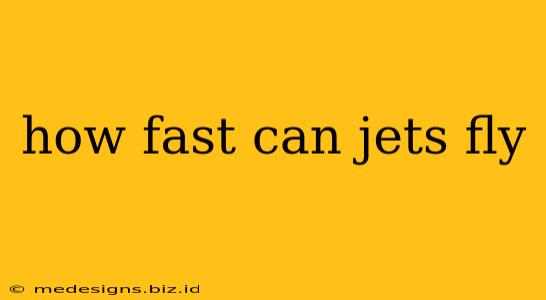Have you ever looked up at a jet plane streaking across the sky and wondered, "Just how fast is that thing going?" The answer, as you might expect, isn't a simple number. The speed of a jet depends on a multitude of factors, from its design and engine power to the altitude and weather conditions. Let's explore the fascinating world of jet speeds.
Factors Affecting Jet Speed
Several key elements influence how quickly a jet can travel:
1. Aircraft Design:
-
Aerodynamics: The shape of the aircraft plays a crucial role. Sleek, streamlined designs minimize drag, allowing for higher speeds. Think of the difference between a modern, delta-winged fighter jet and a larger, less aerodynamic airliner.
-
Engine Type and Power: More powerful engines translate to higher speeds. Different jet engines, such as turbofans, turboprops, and ramjets, offer varying levels of thrust and efficiency. Modern turbofan engines, especially those on long-haul airliners, are marvels of engineering, optimizing fuel efficiency and power.
2. Altitude and Atmospheric Conditions:
-
Altitude: Jets typically fly at high altitudes (cruising altitude) where the air is thinner, resulting in less drag and allowing for higher speeds.
-
Wind: Headwinds slow a jet down, while tailwinds increase its ground speed. Jet streams, powerful high-altitude winds, can significantly impact overall travel time. Weather patterns, including turbulence, can also affect speed and necessitate adjustments.
3. Payload and Fuel:
-
Weight: A heavier jet, carrying more passengers, cargo, or fuel, will naturally be slower than a lighter one. This is a simple matter of physics – more mass requires more energy to accelerate and maintain speed.
-
Fuel: As fuel is consumed during flight, the jet's weight decreases, leading to a slight increase in speed over time.
Different Types of Jets and Their Speeds
The speed of a jet varies considerably depending on its purpose and design:
Commercial Airliners:
These typically cruise at speeds around 500-600 mph (800-970 km/h). This speed is optimized for fuel efficiency and passenger comfort. Faster speeds would burn more fuel and increase passenger discomfort.
Military Fighter Jets:
These are designed for speed and maneuverability. Many fighter jets can easily exceed Mach 1 (the speed of sound, approximately 767 mph or 1235 km/h). Some even reach Mach 2 or even higher speeds!
Business Jets:
These offer a balance between speed and comfort, often cruising at speeds between 450-550 mph (725-885 km/h). This is significantly faster than commercial airliners on a per-passenger basis, but they carry fewer people.
The Future of Jet Speed
Ongoing advancements in aviation technology constantly push the boundaries of jet speed. Research into new materials, engine designs, and aerodynamic principles may lead to even faster jets in the future. However, practical considerations like fuel efficiency and environmental impact also play significant roles in shaping future jet speed limitations.
Conclusion
So, how fast can jets fly? The answer is complex and depends on several factors. While commercial jets typically cruise at speeds around 500-600 mph, military jets can easily break the sound barrier and exceed Mach 1. Understanding the intricacies of jet speed highlights the remarkable engineering feats involved in air travel and the constant pursuit of faster, more efficient flight.
